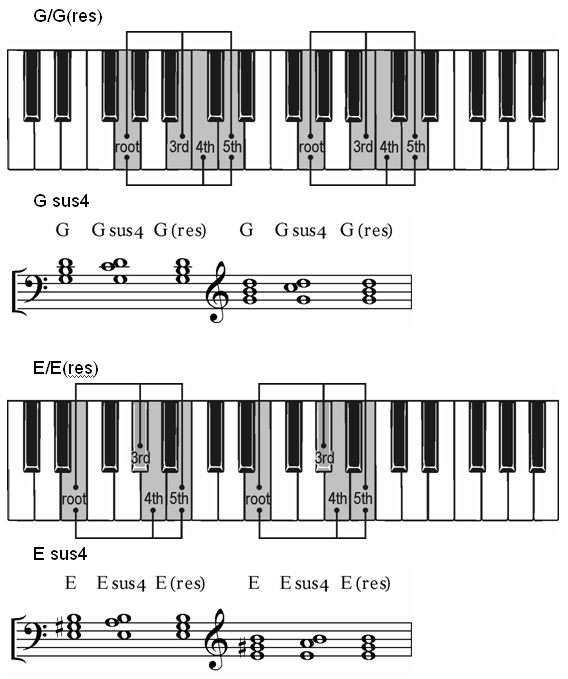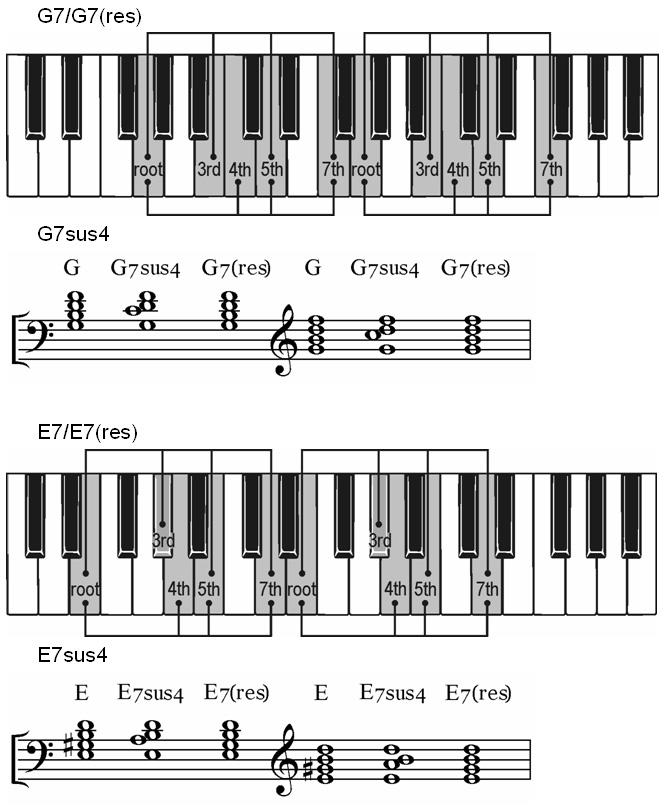The Pyramids Variations
Pyramids Using Suspensions
Suspensions are an easy way to get more out of chords.
A suspension is the temporary raising by one step of a chord tone. Releasing the note back into its proper position is called ‘resolving’ the suspension, or its ‘resolution’.
Listen to the module performance and see if you can hear this happening.
Pyramids chords suspensions
Suspensions are indicated in chord symbols by ‘sus’ for the suspension and (sometimes) ‘res’ for the resolution.
Here are some simple G and E suspended and resolved chords.
(The audio/MIDI reference file covers both examples.)

The root, third or fifth of a chord can be suspended and then resolved (raised and then lowered). These are the bottom, middle and top notes of a root position (BMP) triad. But the third – the middle note of a BMP chord or root position triad – is the note which is most often ‘suspended’. It is pulled up into the fourth step above the root.
The Pyramids material puts ‘sus4’ to help you see that it is the third that has been raised a step to the fourth. Usually you would just see ‘sus’ which on its own means ‘raise the third of this chord a step to the fourth’.
The Pyramids workbook also puts ‘res’ at the place the fourth falls back to its home position – another helpful reminder you won’t usually find in sheet music. Usually you would just see the chord symbol repeated, but without the ‘sus’, and that is how you would know to let the suspended note fall back.
You need quite a bit of time on one chord for a suspension/resolution pair. The obvious place in Pyramids to use the suspension/resolution option is the two bars of chord E (bars 7 and 8 of the 16-bar A1A2 version).
Here are some examples.(The audio file covers all three.)

The Esus4 chords in the third bar of this line of music are the Esus4 chords shown on the keyboard diagram below.
Here is the same technique applied to the Descending Variations.

Here is the same suspension/resolution technique in the four-four 3+3+2 pattern.

In this case, the Esus4 chord resolves to a first inversion chord – but the suspended fourth stills falls back to the third according to plan.
Pavane in the Circle of Fifths with suspensions
The next piece of music is a slow Pyramids variation with plenty of time for suspensions and resolutions. (A pavane is a slow dance.) As well as the three-note suspensions and resolutions shown above, the Pavane uses seventh chords with suspended fourths. You can see that the bottom three notes do exactly the same as the ordinary sus-res chords – they just have an added seventh.

The usual chord symbols would be ‘G7sus’ and plain ‘G7’ (for example), but the music here gives you the helpful extra ‘res’ indication, as before.
Two simplified versions of the Pavanne have been incorporated as TPVD 17-05-16: Two Pavanne Studies.
Here is the MidiPiano performance. You can play either or both of these as an introduction to the full version for an extended segue performance
|
OUT NOW! |
THE MUSICARTA BEAT & RHYTHM WORKBOOK At last! An effective approach to keyboard rhythm & syncopation skills. Learn more! |
ONLY $24.95! |
PYRAMIDS
|
The MusicartaA methodical approach to keyboard syncopation for
|
PUBLICATIONS
exciting keyboard
creativity courses
CHORDS 101
WORKBOOK

~HANON~
video course

Musicarta
Patreon
PENTATONICS
WORKBOOK
video course

Creative Keyboard
video course

BEAT AND RHYTHM
WORKBOOK

- Volume 1 -

12-BAR PIANO
STYLES WORKBOOK

MUSICARTA MODES
WORKBOOK

PIANO STYLE

CANON PROJECT
video course

VARIATIONS
video course


- Piano Solo -
video course

- Piano Solo -


YouTube playlists





 THE LOGO
THE LOGO
